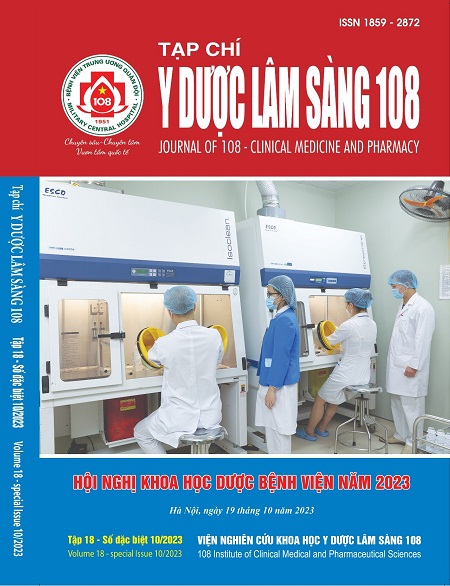Distribution and antibiotic resistance characteristics of Escherichia coli causing urinary tract infections at the 108 Military Central Hospital from May 1, 2022, to April 30, 2023
Main Article Content
Keywords
Abstract
Objective: To determine the infection rate and antibiotic resistance characteristics of E. coli causing urinary tract infection at the 108 Military Central Hospital from May 1, 2022, to April 30, 2023. Subject and method: All urine samples from patients suspected of urinary tract infection were cultured, identified, and subjected to antibiotic susceptibility testing. Data for identification and antibiotic susceptibility testing from urine specimens were collected in the Microbiology Department at 108 Military Central Hospital. All microbiological tests were conducted following the standard procedure recognized by ISO:15189-2012. Result: Among 6561 urine samples cultured from May 1, 2022, to April 30, 2023, there were 1029 positive cases, accounting for a rate of 15.68%. The Gram-negative bacteria infections accounted for 73.08%, Gram-positive bacteria for 20.12%, and fungal for 6.8%. The highest positive urine culture rate was observed in the Institute of Clinical Infectious Diseases (23.26%). E. coli was the most common pathogen causing urinary tract infections, accounting for 45.15% of cases in the entire hospital and 10.51% in the Intensive Care Unit. E. coli showed high sensitivity to antibiotics such as fosfomycin (96.71%), Nitrofurantoin (92.81%), carbapenems (Meropenem, Imipenem, Ertapenem) with over 90%, Amikacin (81.14%), and resistance was high against third generation Cephalosporins and Quinolone antibiotics. The rate of ESBL-producing E. coli was 60.77%. Antibiotic resistance was higher in ESBL-producing E. coli compared to non-ESBL strains, except for carbapenem antibiotics. Conclusion: The positive urine culture rate is 15.68%, with E. coli being the leading pathogen, accounting for 45.15%. E. coli demonstrated good sensitivity to antibiotics such as Fosfomycin, carbapenems, and Amikacin. ESBL-producing E. coli accounted for 60.77% and exhibited higher antibiotic resistance compared to non-beta-lactamase-producing strains, except for carbapenem antibiotics.
Article Details
References
2. Nguyễn Thị Ngọc Anh (2020) Nghiên cứu tỷ lệ và tính kháng kháng sinh của các vi khuẩn gây nhiễm khuẩn tiết niệu tại Bệnh viện Quân y 103 (01/2017 – 12/2019). Luận văn thạc sĩ y học, Học viện Quân y.
3. Nguyễn Huy Hoàng (2021) Tình hình nhiễm trùng tiết niệu ở phụ nữ mang thai tại Bệnh viện Phụ sản nhi - Đà Nẵng. Vietnam medical journal, 2, tr. 154-159.
4. Phan Thị Lụa (2021) Tỉ lệ nhiễm và tính kháng kháng sinh của vi khuẩn gây nhiễm khuẩn tiết niệu ở bệnh nhân điều trị tại Bệnh viện Hữu nghị Đa khoa Nghệ An năm 2020. Truyền nhiễm Việt Nam, 2, tr. 58-64.
5. Bộ Y tế (2020) Báo cáo kết quả giám sát kháng kháng sinh quốc gia năm 2020.
6. Sherchan JB, Dongol A, Humagain S et al (2022) Antibiotic susceptibility pattern of bacteria causing urinary tract infection. J Nepal Health Res Counc 20(1): 218-224.
7. Gebretensaie Y, Atnafu A, Girma S, Alemu Y, Desta K (2023) Prevalence of bacterial urinary tract infection, associated risk factors, and antimicrobial resistance pattern in Addis Ababa, Ethiopia: A cross-sectional study. Infection and Drug Resistance 16: 3041-3050.
8. Saravanan M, Ramachandran B, Barabadi H (2017) The prevalence and drug resistance pattern of extended spectrum β–lactamases (ESBLs) producing Enterobacteriaceae in Africa. Microbial Pathogenesis 17: 1-51.
9. Gruszecka J, Filip R (2023) Urinary tract infections in patients hospitalized in a gastroenterology department study from a tertiary regional hospital in South-East Poland. Gastrointest Disord 5: 198- 208.
10. Lương Thị Hồng Nhung và cộng sự (2022) Đặc điểm kháng kháng sinh của một số vi khuẩn gram âm sinh enzyme beta lactamase phổ rộng phân lập tại Bệnh viện Trung ương Thái Nguyên năm 2018-2020. Tạp chí Y học Việt Nam tập 512 -Tháng 3-Số2 -2022, tr. 229-230.
11. Niccodem EM, Mwingwa A, Shangali A et al (2023) Predominance of multidrug-resistant bacteria causing urinary tract infections among men with prostate enlargement attending a tertiary hospital in Dar es Salaam, Tanzania. Bulletin of the National Research Centre 47: 1-10.
 ISSN: 1859 - 2872
ISSN: 1859 - 2872
